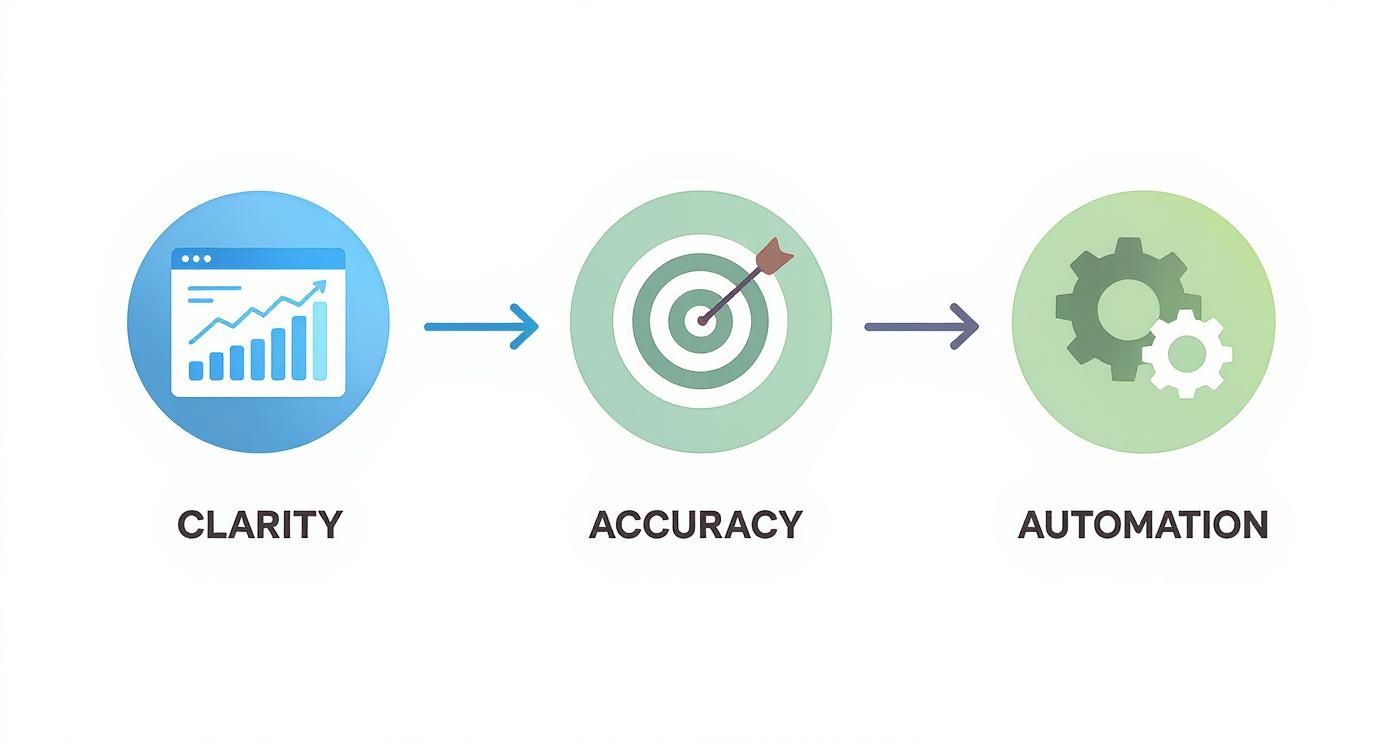When we talk about integration in project management, we're not just talking about another piece of tech jargon. We're talking about connecting all your separate software tools and processes so they act like a single, intelligent system. It’s the difference between having a pile of high-quality engine parts and having a fully assembled, roaring engine.
This connection gets rid of mind-numbing manual data entry, clears up communication channels, and gives you a crystal-clear, real-time picture of where every project stands. It's how you turn a jumble of individual apps into a cohesive operational machine.
Why Integration Is Your Project Management Superpower
Think of your project team and all the tools they use as a high-performance engine. Your CRM, time tracker, and PM platform are all crucial components. Without integration, they're just expensive parts sitting in a box, producing zero power. But when they're connected, they fire in perfect harmony, propelling your projects forward at full speed.
That's the real power of integration in project management. It’s moved from a "nice-to-have" feature to a fundamental strategy for any modern business that wants to be efficient and competitive. It directly tackles the most common headaches that sink projects—blown deadlines, busted budgets, and messy communication.
The Real Cost of a Disconnected Workflow
When your systems operate in isolation, you get information silos. Your sales team lives in the CRM, the project managers are glued to their PM tool, and the finance team is swimming in spreadsheets. This forces your people to become human APIs, manually copying and pasting data from one system to another. It's not just painfully slow; it's a recipe for costly mistakes.
This disconnect isn't just an annoyance; it has a measurable impact. While a whopping 77% of high-performing organizations see project management as a core strategic advantage, the reality is that only about 35% of projects globally are actually completed on time and on budget. That massive gap is often a direct result of disjointed tools and processes.
To give you a better idea of how this plays out, let's compare the two worlds side-by-side.
Fragmented vs. Integrated Project Workflows
Here’s a quick comparison showing the practical impact of connecting your tools and processes versus working in isolated silos.
| Aspect | Fragmented Workflow (The Challenge) | Integrated Workflow (The Solution) |
|---|---|---|
| Data Entry | Manual, repetitive data entry across multiple platforms. High risk of human error. | Data syncs automatically between systems, eliminating double-entry and errors. |
| Visibility | Information is trapped in silos. No single, reliable view of project health. | A "single source of truth" provides real-time visibility for everyone. |
| Communication | Teams communicate in separate channels, leading to missed updates and confusion. | Centralized updates and notifications keep everyone on the same page. |
| Reporting | Compiling reports requires manually exporting data from several tools and merging spreadsheets. | Automated, cross-platform reports are generated in minutes, not hours. |
| Efficiency | Team members waste valuable time on low-value administrative tasks. | Automation handles the busywork, freeing up the team for strategic, high-impact tasks. |
The difference is stark. One path leads to confusion and inefficiency, while the other paves the way for clarity and high performance.
Building a Truly Connected Ecosystem
Integration is about turning that fragmented landscape into a smart, connected ecosystem. Instead of your team manually bridging the gaps between software, you let automated workflows do the heavy lifting. Information flows freely and instantly, giving you an unobstructed view across the entire project lifecycle.
A properly integrated system unlocks a few massive advantages:
- Sharp Visibility: From the CEO down to the newest team member, everyone can see real-time project status without chasing people for updates.
- Rock-Solid Accuracy: Automation doesn't make typos. By taking human error out of the equation for data entry, your numbers become far more reliable.
- A Major Boost in Efficiency: Your team gets to spend less time on tedious admin work and more time actually moving the needle on important projects.
By focusing on this seamless flow of information, you're not just buying another tool—you're building a foundation for a more strategic and successful way of working. Dive into our guides on specific software integrations to see how you can start creating a more connected workflow today.
Unlocking the Most Powerful Types of Integrations
While the big idea of "integration" is great, its real value is in connecting the right tools to solve specific problems. Let's move past the theory and dig into the types of integration in project management that deliver the biggest, most immediate impact on how you work every day. Each one acts like a specialized bridge, wiping out a common operational headache.
Think of these less as technical add-ons and more as automated assistants. They're built to handle all the tedious handoffs that are currently slowing your team down.
From Won Deal to Project Kickoff Instantly
For most businesses, a Customer Relationship Management (CRM) integration is the first and most powerful connection to make. It creates a seamless link between your sales pipeline and your project delivery engine.
Picture this: your sales team flips a deal to "Won" in your CRM. Instead of a storm of emails and someone manually creating a new project, the integration kicks off a workflow automatically. A new project pops into your PM tool, client details are copied over, and the first few tasks are assigned. Just like that, you've eliminated the risky manual handoff, ensuring no details get lost and the project starts hours—or even days—sooner.
Taming the Calendar Chaos
Calendar integration is another absolute must-have. Your team's availability is your most crucial—and most unpredictable—asset. Without a live link between your project management tool and everyone’s calendars, you’re basically flying blind.
This is what stops the nightmare of double-booking your star designer or setting a huge deadline when your lead developer is on vacation. It gives you a real-time, unified view of who can do what and when, making your resource planning and project timelines far more grounded in reality.
By syncing project timelines with actual calendars, managers move from guessing about availability to making data-driven scheduling decisions, reducing the risk of burnout and missed milestones.
Automating Time and Performance Tracking
Time-tracking and reporting integrations are where you find the truth about project profitability and team performance. Let's be honest, manually filling out timesheets is a task everyone hates, and the results are famously inaccurate.
- Time-Tracking Integration: This is a lifesaver. It automatically logs hours spent on tasks and meetings straight from your calendar or PM tool, cutting down manual data entry to almost zero.
- Reporting & BI Integration: This connection funnels data from your project tools into Business Intelligence (BI) platforms. It lets you build live dashboards to see project health, team utilization, and budget burn rates without spending half your day wrestling with spreadsheets.
For teams deep in tools like Asana, these connections aren't just nice—they're essential. To see these ideas in action, you can explore the best Asana integrations for 2024 and find ways to sharpen your own workflows.
Creating Custom Connections with APIs
Finally, for those unique or super-specific needs, API and webhook integrations open up a world of possibilities. Think of an API (Application Programming Interface) as a universal adapter that lets two systems talk to each other, even if they weren't designed to.
This is your go-to when a standard, off-the-shelf integration just doesn't cut it. For example, you could build a custom link that automatically sends a client a satisfaction survey through your marketing tool the exact moment a project is marked "Complete" in your PM software. These custom connections let you build a tech stack that works exactly the way your business does.
The Real-World Payoff of a Connected Workflow
Connecting your tools isn't just a technical upgrade; it's a fundamental shift in how your entire business operates. A fully integrated system delivers tangible, game-changing results that ripple across every department, from sales all the way to finance. It rewrites your decision-making process, boosts team morale, and directly impacts your bottom line by stamping out costly inefficiencies.
The real magic happens when you move from being reactive—constantly chasing updates and fixing errors—to proactive. When data flows freely, you get a clear, real-time picture of your entire operation without lifting a finger.
Achieve Radical Project Clarity
In a disconnected setup, project managers spend a shocking amount of time just hunting for information. They’re chasing status updates, manually compiling reports, and trying to stitch together a coherent story from scattered data points. An integrated workflow completely flips this script.
Instead of navigating a maze of spreadsheets and email chains, a manager can see the entire project lifecycle on a single dashboard. From the initial sales inquiry logged in the CRM to the final task checked off in the PM tool and the hours logged against it—everything is in one place. This single source of truth empowers leaders to spot bottlenecks early, reallocate resources on the fly, and make informed decisions based on live data, not guesswork.
Eliminate Soul-Crushing Manual Data Entry
Let’s be honest: repetitive, manual data entry isn’t just tedious, it’s a productivity killer and a breeding ground for human error. Think about it. When an employee has to copy info from a CRM record into a project brief, then into a timesheet, and finally onto an invoice, the risk of a typo multiplies at every step. This leads to inaccurate reports, awkward billing disputes, and wasted hours that should have been spent on valuable client work.
A connected system automates this entire chain reaction. The immediate benefits are obvious:
- Error Reduction: Automated data syncs mean what you see in one system is what you see in all of them. No more discrepancies.
- Time Savings: Teams get back the hours they used to lose to administrative busywork.
- Improved Morale: Freeing your team from mind-numbing copy-paste tasks lets them focus on the strategic, engaging parts of their job.
This is a bigger deal than it sounds. Studies show that less than half (45%) of businesses using project management tools actually get the results they expect, often because of poor integration and communication gaps. A connected workflow directly tackles these core problems. You can dig into these project management findings on Flowlu to see the data for yourself.
Secure Bulletproof Billing Accuracy
For agencies and professional services firms, billing integrity is everything. When your time-tracking and invoicing systems don't talk to each other, you're practically inviting revenue leakage. Forgotten time entries, incorrect billing codes, and invoicing delays all cut directly into your profits and can seriously damage client trust.
Integration in project management bridges the gap between work performed and revenue collected. When time tracking is automated and synced directly with invoicing, you create an unbreakable, auditable trail from task to payment.
This simple connection ensures every single billable minute is captured accurately and invoiced promptly. It strengthens your cash flow and virtually eliminates those uncomfortable client calls about "surprise" charges.
Unlock True Workflow Automation
Ultimately, a connected workflow is about more than just syncing data; it’s about creating intelligent, automated processes that run your operations for you. When your systems can talk to each other, you can build powerful "if-this-then-that" sequences that handle routine tasks without any human intervention.
Imagine this: marking a project as "complete" in your PM tool could automatically trigger the final invoice, notify the client of project delivery, and archive all the project files. That’s the power of true automation. If you're ready to get started, you can learn more about how to automate repetitive tasks in our detailed guide.
Your Blueprint for a Successful Integration Strategy
Jumping into an integration project without a solid plan is a lot like setting off on a road trip without a map. Sure, you might get somewhere eventually, but you’re practically guaranteed a few wrong turns, wasted hours, and a whole lot of frustration along the way.
A winning strategy for integration in project management isn't about guesswork. It’s built on thoughtful planning, crystal-clear goals, and getting the whole team on the same page from day one. This framework will walk you through the essential steps, ensuring you connect your tools with purpose, not just for the sake of adding another shiny object to your workflow.
Start With a Tech Stack Audit
Before you even think about adding something new, you have to get honest about what you're already working with. It's time for a thorough audit of your current software stack. Map out every single tool your teams are using, but more importantly, pinpoint exactly where the workflow stumbles and breaks down.
Ask yourself and your team some tough questions:
- Where are people stuck doing the most manual data entry?
- Which information silos are causing the biggest headaches or delays?
- What are the simple, repetitive tasks eating up the most hours each week?
The answers will act like a spotlight, illuminating the weakest links in your operational chain and showing you exactly where an integration will deliver the biggest bang for your buck.
Define Clear Integration Goals
Your integration goals need to be tied to real, measurable business outcomes. Fuzzy objectives like "improving efficiency" just won't cut it. You need specific, measurable targets that directly support your company's bigger mission.
For example, a clear goal sounds more like this: "We will reduce the time spent on manual invoicing by 50% within three months by integrating our PM tool with our accounting software." That gives you a tangible benchmark for success and keeps the project from drifting off course. If you want to dive deeper into strategic frameworks for process optimization, the Content Marketing Operations Maturity Model is a great resource.
The journey from a messy workflow to a smooth, automated one is a clear progression, as you can see below.
This path shows that true automation isn't just a switch you flip. It's built on a solid foundation of data clarity and accuracy—the very things a smart integration plan is designed to create.
Prepare Your Team for the Change
The tech is only half the battle. Your people are the other, more important half. One of the most common pitfalls is completely underestimating the need for good training and open communication. Introduce the new, connected workflow early and be very clear about the "why" behind it all.
The most successful integration projects are those where the team sees the new connections as a solution to their daily frustrations, not just another tool they are forced to use.
Show them how this new system is going to make their lives easier by killing off the tedious tasks they hate. Offer hands-on training, create cheat sheets, and set up a go-to person for questions during the transition. When your team is genuinely on board, adoption happens faster, and you start seeing the benefits that much sooner.
How to Measure Your Integration Success
Investing in integration in project management feels like a win, but how do you actually prove it's working? To justify the effort and build a solid case for future investments, you have to move beyond fuzzy goals like "improving efficiency." It's time to start tracking specific Key Performance Indicators (KPIs).
Think of these metrics as your integration's report card. They transform a hopeful strategy into a measurable business victory, showing you exactly where your connected tools are delivering real value. This data is your most powerful asset for proving ROI to stakeholders and getting your team excited about what's next.
Key KPIs for Efficiency Gains
Efficiency is usually the big reason you integrate in the first place, and thankfully, its impact is easy to measure. When your systems start talking to each other automatically, the time your team spends on soul-crushing admin work should drop. Fast.
- Time Saved on Manual Reporting: This is a huge one. First, figure out how many hours your team used to burn manually exporting data and piecing together reports. Then, compare that to the time it takes with your new automated setup. A 60-70% reduction is not only possible but a fantastic story to tell.
- Decrease in Administrative Task Hours: Look at the time spent on repetitive tasks, like manually creating a new project in your PM tool every time a deal is marked "won" in your CRM. After integration, this number should plummet, freeing up your team for the strategic, high-value work they were actually hired to do.
When you put a number on the time saved, you're not just showing a productivity bump. You're translating those hours directly into payroll savings and creating more capacity for billable work. It's a clear financial win.
Metrics for Accuracy and Financial Health
A connected workflow doesn't just make you faster—it makes you more accurate. And that has a direct, positive impact on your bottom line. Fewer manual data handoffs mean fewer expensive mistakes slip through the cracks.
- Reduction in Billing Disputes: This metric speaks volumes. When your time tracking tool syncs flawlessly with your project management and invoicing software, billing becomes transparent and ironclad. Start tracking the number of client billing questions or disputes you handle each month. A successful integration will cause that number to drop noticeably.
- Improved Timesheet Accuracy: Compare the detail and consistency of timesheets before and after the integration. It's a night-and-day difference. Automated time capture from tools like Google Calendar or your project software blows manual entry out of the water, which strengthens billing integrity and makes your project cost estimates way more reliable.
Key KPIs for Measuring Integration Success
Tying your integration efforts to specific business goals is crucial. This table gives you a quick reference for aligning your objectives with the right metrics, so you can track what truly matters.
| Business Goal | Relevant KPI | How to Measure It |
|---|---|---|
| Increase Productivity | Time Saved on Manual Tasks | Pre- vs. post-integration time tracking for specific admin workflows. |
| Improve Financials | Reduction in Billing Errors | Monthly count of client billing disputes or invoice correction requests. |
| Boost Team Adoption | User Engagement with New Workflow | Analytics showing the percentage of team members actively using the integrated features. |
| Accelerate Projects | Shorter Project Initiation Time | Time from a deal marked "Won" in CRM to project kickoff in the PM tool. |
By focusing on these KPIs, you stop guessing and start knowing. You can build a clear, compelling story about the power of integration in project management. It’s how you prove that connecting your systems isn’t just a tech upgrade—it’s a strategic move that delivers real, measurable value across the entire organization.
Putting Integration Into Practice: A Real-World Example
It’s one thing to talk about benefits in theory, but it’s another to see integration in project management completely change how a real business operates. Let’s look at a story you’ve probably seen before.
Meet "PixelPerfect," a mid-sized creative agency. They were drowning in the classic symptoms of a disconnected workflow: chasing down timesheets, manually updating project statuses in three different places, and constantly guessing who was available to work on what.
The sales team practically lived inside their CRM. Meanwhile, designers were working off briefs in a totally separate tool, and the finance team had to piece together invoices from a messy trail of calendar entries and spreadsheets. The whole process was slow, riddled with errors, and a massive source of frustration for everyone.
The Moment a New Client Signs
At PixelPerfect, the old way of onboarding a client was a manual nightmare. The second a sales lead marked a deal as "Won" in the CRM, it set off a frantic chain of emails. A project manager would have to stop what they were doing, manually create a new project, copy and paste every last client detail, and then start begging the team for time slots to schedule a kickoff meeting.
With their new, integrated system, that chaos is gone. The moment a deal is won, a beautiful, automated sequence kicks off:
- A new project is automatically created in their project management tool, pulling the client's name, contact info, and project scope straight from the CRM. No more typos or missed details.
- A corresponding project folder is generated in their shared drive, giving all future assets a central, organized home from day one.
- Key milestone deadlines are auto-populated into the shared team calendar, so everyone has immediate visibility.
- Time-tracking categories for the new client are set up instantly, ready for the team to log their hours against the right project without any confusion.
This one automated workflow saves countless hours of tedious admin work. More importantly, it ensures a smooth, professional handoff from sales to the delivery team, every single time. Details no longer get lost in translation.
Solving the Timesheet and Billing Nightmare
Before they integrated their tools, getting accurate time logs was PixelPerfect’s biggest headache. Team members would forget to fill out their timesheets, leading to a mad dash of rushed, inaccurate entries at the end of the week. This wasn't just an annoyance—it directly hurt their billing integrity and made it impossible to know if projects were actually profitable.
The fix was simple but powerful: they connected their team’s calendars directly to their project management and billing systems. Suddenly, time tracking became almost effortless.
By treating the team's calendar as the primary source of truth for time tracking, the agency eliminated the friction of manual timesheets. This shift didn't just improve accuracy; it gave them a real-time view of project costs and team utilization.
Now, meetings and scheduled work blocks on their calendars are automatically captured and categorized. A project manager can pull up a live dashboard and see exactly how many hours have been logged against a project’s budget at any given moment.
When it’s time to send an invoice, the finance team generates a detailed report with a single click, confident that every last billable minute has been accounted for.
For PixelPerfect, this level of integration in project management wasn’t just a small tweak. It was a complete operational overhaul that gave them the clarity and control they desperately needed to scale their business.
Common Questions on Project Management Integration
Getting started with integrations can feel like a big step, so let's tackle some of the most common questions that come up. Here are a few things people often ask when they're figuring out how to connect their tools.
What Is the Best Integration to Start With?
If you're just dipping your toes in, the biggest and fastest win is almost always connecting your project management tool to two things: your team's chat app (like Slack or Teams) and your calendar (like Google Calendar).
This combo hits two major pain points right away. It brings project updates directly into the conversations you're already having, and it syncs calendars to give everyone a clear, shared view of availability. It’s an easy victory that delivers a noticeable improvement almost immediately.
Can I Connect Tools from Different Companies?
You absolutely can. In fact, you should! Most modern software is built to play nicely with others through what are called Application Programming Interfaces (APIs). You also have fantastic third-party services like Zapier or Make that act as universal translators between apps.
The smart move is to always check for "native integrations" first. These are the pre-built connections that are usually the most stable and dead simple to set up. If you can't find one, that's when a platform like Zapier becomes your best friend, bridging the gap between almost any two tools you can think of.
Your goal isn't brand loyalty; it's building a seamless, functional ecosystem. The best tech stack is about picking the right tool for each job and making them all talk to each other, not forcing everything to come from one provider.
How Much Technical Skill Do I Need?
It really depends on what you're trying to do. The good news is that many integrations are now completely "no-code," meaning they’re designed for the average user. If you can follow a setup wizard and click a few buttons, you can get them running.
But if you need something more specific—say, connecting to a custom-built internal system—that's when you might need to bring in a developer who knows their way around an API. A great approach is to start with the simple, out-of-the-box integrations to solve your immediate problems. You can always scale up to more complex, custom solutions as your business grows.
Ready to get a real-time grip on your projects and finally ditch the headache of manual timesheets? TimeTackle plugs right into your team's calendar to automate time tracking and deliver the insights you need to work smarter. See how we can bring clarity to your workflow by visiting us at https://www.timetackle.com.







